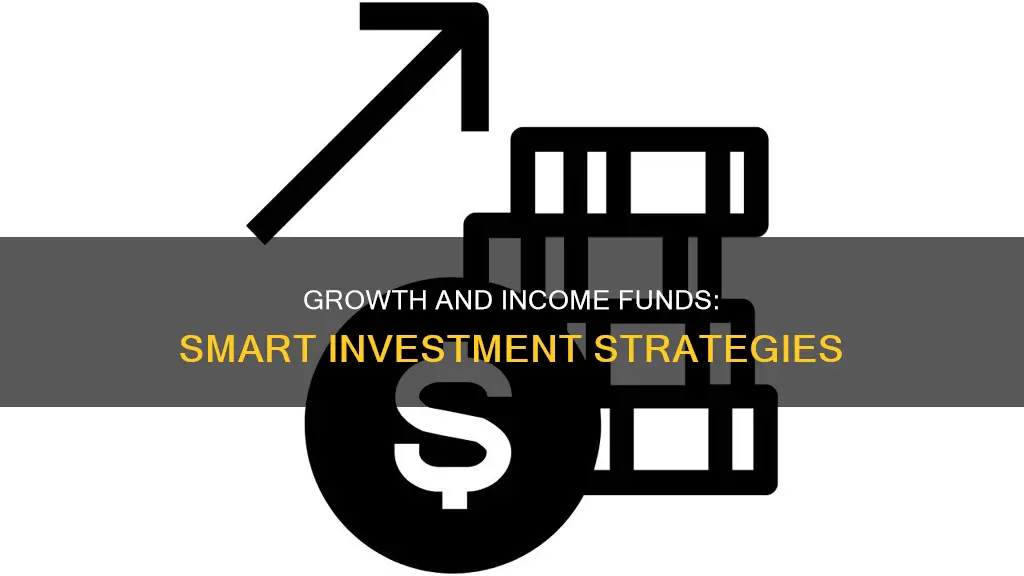
Growth and income funds are a class of mutual funds or exchange-traded funds (ETFs) that have a dual strategy of both capital appreciation and current income generated through dividends or interest payments. They are popular among investors with moderate appetites for risk and are especially attractive when the broad economy looks to be weakening. These funds are suitable for investors who want to increase the value of their investments over time and are happy to wait to cash in on their investments. On the other hand, income funds are for investors who want their investments to pay out to them regularly.
| Characteristics | Values |
|---|---|
| Type of fund | Mutual fund or exchange-traded fund (ETF) |
| Investment strategy | Dual strategy of capital appreciation (growth) and current income generated through dividends or interest payments |
| Investment mix | Equities, stocks, bonds, real estate investment trusts (REIT), other securities, or a combination of these |
| Risk appetite | Moderate (but not excessive) |
| Returns | Typically lag those of pure growth funds |
| Time horizon | Depends on the age of the investor; longer for younger investors, shorter for older investors |
| Equity exposure | Decreases as an investor ages |
| Volatility | Low |
What You'll Learn

Growth and income funds for retirement
Growth and income funds are a class of mutual funds or exchange-traded funds (ETFs) that have a dual strategy of both capital appreciation (growth) and current income generated through dividends or interest payments. They are popular among investors with moderate appetites for risk, especially those seeking a steady income stream for retirement.
How They Work
Growth and income funds invest in a combination of stocks, bonds, real estate investment trusts (REITs), and other securities. They aim to create a diversified portfolio that takes advantage of the growth potential of the "growth segment" and the dividend income and stability of the "value segment".
For example, a growth and income fund may invest in dividend-paying stocks, which offer regular payments to shareholders. While share prices may fluctuate, these stocks have the potential to gain value and pay reliable dividends, especially in a volatile market.
Additionally, the fund may invest in bonds, which provide regular, high-quality income through interest payments. In a low-interest-rate environment, investors can take limited risks and potentially earn more than fixed-income investments.
Risk and Returns
Growth and income funds are suitable for investors who want stability without sacrificing returns that outpace inflation. These funds are particularly attractive when the broader economy appears to be weakening.
The percentage of equity exposure in a growth and income fund shifts as investors' time horizons shorten. Generally, growth allocations decrease as an investor ages, with a rule of thumb being that individuals should subtract their age from 100 to determine the percentage of stocks they should hold.
Retirement Considerations
When planning for retirement, it is essential to consider income needs. Financial advisors recommend that retirees replace approximately 75% of their working wages with income-producing securities such as bonds and large-cap dividend-paying equities.
A balanced fund, which holds a significant allocation of corporate and government bonds, can provide semi-annual interest payments while preserving capital. The less volatile nature of U.S. Treasury and investment-grade bonds, coupled with the growth potential of stocks, ensures that retirees have a steady income stream and a potential rate of appreciation to combat rising costs.
Examples of Growth and Income Funds
The Dodge and Cox Balanced Fund ("DODBX") is an example of a growth and income fund. As of June 30, 2022, it had a 10-year average annual return of 9.91%, exceeding its comparative index. However, its yield dropped below the yield on the 10-year Treasury, demonstrating that returns may vary based on economic conditions.
Another example is the Vanguard Growth and Income Fund Investor Shares ("VQNPX"), which lists volatility as a key risk due to its full exposure to the stock market.
Growth and income funds can be a valuable tool for retirees or those planning for retirement. They provide a diversified approach to investing, balancing growth potential with steady income generation. However, it is important to research each fund's strategy and consider your risk tolerance, time horizon, and financial goals when making investment decisions.
International Funds: Diversify Your Portfolio, Gain Global Exposure
You may want to see also

Growth funds for beginners
Growth funds are a great way to grow your money, but they can be intimidating for beginners. Here are some tips to help you get started:
Understand Growth Investing
Firstly, it's important to understand what growth investing is. Growth investing is the pursuit of increasing your wealth through long- or short-term capital appreciation. It is often considered the "offensive" portion of an investment portfolio, while the "defensive" portion focuses on income generation, tax reduction, or capital preservation. When it comes to stocks, "growth" means that the company has substantial potential for capital appreciation.
Assess Your Risk Tolerance
Before investing in growth funds, it's crucial to assess your risk tolerance. Growth investments typically come with a higher level of risk. Consider your financial goals and how much risk you are comfortable taking on. Are you willing to accept higher risks for potentially greater returns, or do you prefer stability? Your risk tolerance will guide the types of growth investments you choose.
Types of Growth Investments
There are several types of growth investments to choose from. Here are some options:
- Small-cap stocks: These are stocks of companies with a market capitalization between $300 million and $2 billion. They usually have a higher potential for price appreciation but also carry more risk.
- Technology and healthcare stocks: Investing in companies that develop new technologies or offer healthcare innovations can provide high returns but also come with higher risk.
- Speculative investments: These include penny stocks, futures and options contracts, foreign currency, and speculative real estate. These are high-risk investments that can offer high returns but can also result in significant losses.
Research and Diversify
When investing in growth funds, it's important to research and diversify your investments. Don't put all your eggs in one basket. Spread your investments across different companies, industries, and asset classes to reduce risk. Consider factors such as the rate of growth, the amount and type of risk, and other elements of investing.
Start with a Small Amount
You don't need a large sum of money to start investing in growth funds. Many online brokers have low minimum deposit requirements or even no minimum at all. You can start with a small amount and gradually increase your investments as you gain more knowledge and confidence.
Seek Professional Advice
If you're a beginner, consider seeking advice from a financial advisor or broker. They can provide personalized guidance based on your financial goals, risk tolerance, and investment style. Full-service brokers offer a range of financial services, while discount brokers provide more streamlined services at lower costs. Robo-advisors are also an option for automated investment management.
Smart Ways to Invest $25,000 in Mutual Funds
You may want to see also

Income funds for beginners
Income funds are a type of mutual fund or exchange-traded fund (ETF) that offers a dual strategy of capital appreciation (growth) and current income (dividends or interest payments). They are suitable for investors with moderate risk appetites who want a "balanced" portfolio.
Income funds aim to create a diversified portfolio that takes advantage of the capital gains potential of growth stocks, while also offering the dividend income and stability of value stocks.
Types of Income Funds
Income funds can invest only in equities or a combination of stocks, bonds, real estate investment trusts (REITs), and other securities.
Examples of Income Funds
The Dodge and Cox Balanced Fund ("DODBX") is an example of an income fund. As of June 30, 2022, it had a 10-year average annual return of 9.91%, exceeding its comparative index. However, its yield dropped below the 10-year Treasury yield, which offered a 1-year return of around 2.832% as of August 4, 2022.
Another example is the Vanguard Growth and Income Fund Investor Shares ("VQNPX"), which has full exposure to the stock market and is therefore considered more volatile than other income funds.
How to Invest in Income Funds
When investing in income funds, it's important to research each fund's strategy and use a style box for easier categorization. These funds come in many configurations, and investors should be aware of their bias, whether towards growth, income, or higher exposure to bonds.
Additionally, income funds can be accessed through mutual funds or ETFs, which offer a diversified range of securities and cut down on transaction costs.
Benefits of Income Funds
Income funds are popular among investors seeking stability without sacrificing returns that outpace inflation. They are particularly attractive when the broader economy appears to be weakening, as they can provide superior performance during these periods.
Considerations for Beginners
When investing in income funds, it's important to consider your risk tolerance and investment objectives. Income funds are suitable for those who want to scale back on growth objectives as retirement approaches. As a general rule of thumb, financial professionals suggest that the percentage of growth allocations should decrease as an investor ages.
Additionally, it's crucial to assess the fees associated with income funds, as lower expense ratios can positively impact your returns over time.
Finally, consider consulting a financial advisor who can provide personalized guidance based on your specific financial situation and goals.
Mutual Funds: Smart, Diverse, and Accessible Investment Vehicles
You may want to see also

Growth funds for higher risk investors
Growth funds are ideal for investors who are happy to wait to cash in on their investments, such as younger people with a long time horizon before retirement. They are also suitable for those who want to put money away in a long-term investment.
Growth funds, also known as accumulation funds, aim to increase the value of your investments over time. They do this by investing in companies with strong growth prospects, which tend to reinvest profits back into business expansion. These companies are often starting from a low base, so they can grow their market share exponentially over the long term.
Growth funds are more volatile than income-producing funds, and they can go up and down in value very quickly and frequently. They may also be less liquid, making it harder to access your money. Therefore, they are higher-risk investments and are only suitable for those who are prepared to lose all of the money invested.
If you are a higher-risk investor, you can choose the share class of a fund that reinvests any dividends to increase the size of your overall pot. This is called the accumulation share class, and it benefits from the effect of compounding. This means that you get returns on your returns.
Remember that growth funds perform best when the economy is growing. They aim to grow at a faster rate than the stock market, but this is not guaranteed.
Maximizing Pension Fund Investments with 80CCC Contributions
You may want to see also

Income funds for lower risk investors
Income funds are a great option for conservative investors who want to protect their money from potential losses while still benefiting from modest growth. While investing in low-risk assets can preserve your capital, it also limits your returns.
U.S. Treasury Bills, Notes and Bonds
U.S. Treasury securities are backed by the full faith and credit of the U.S. government, which has always paid its debts. Treasury bills, also referred to as T-bills, have maturities ranging from four to 52 weeks and are sold at a discount to their face value. Treasury notes come in maturities of two and ten years, while Treasury bonds have long maturities of 20 to 30 years, making them slightly more risky. All of these options provide very low-risk investments with low to moderate potential returns, depending on maturity.
Series I Savings Bonds
Series I savings bonds are a special type of U.S. savings bond that offers a variable interest rate designed to keep up with inflation, as measured by the consumer price index (CPI). They benefit from semiannual compounding, where earned interest is added to the bond's value twice a year, gradually increasing the principal on which interest is earned. While these bonds are considered very low risk, there is a small penalty if you cash out before five years.
Treasury Inflation-Protected Securities (TIPS)
TIPS are issued by the U.S. Treasury and are designed to protect returns from inflation. They offer maturities of five, ten, or 30 years and provide a fixed rate of interest. The principal value of TIPS increases or decreases based on the inflation rate, ensuring that investors do not lose purchasing power.
Fixed Annuities
Fixed annuities are a popular type of annuity contract frequently used for retirement planning, offering a guaranteed fixed rate of return over a set period. They provide financial security, especially during non-working years, and allow for tax-deferred income growth. However, annuities are fairly illiquid, making it challenging to exit without incurring penalties.
High-Yield Savings Accounts
High-yield savings accounts offer a modest return on your money, unlimited liquidity, and FDIC insurance on deposits up to a certain limit. While there is minimal risk of losing money, inflation can erode purchasing power over time.
Certificates of Deposit (CDs)
CDs are time deposit accounts that offer a fixed interest rate for a specific term. Withdrawing money before the maturity date triggers an early withdrawal penalty. They are considered very low-risk investments, insured by the FDIC, and can offer returns comparable to high-yield savings accounts.
Money Market Mutual Funds
Money market mutual funds invest in short-term, low-credit-risk fixed-income securities, providing liquidity and a very low risk of losing money. However, they typically offer modest returns and are not backed by the FDIC.
Investment-Grade Corporate Bonds
Corporate bonds are issued by public companies with high credit ratings, indicating a very likely chance of paying interest and returning principal. While they are considered moderate risk, they can provide modest to high potential returns.
These options can help lower-risk investors achieve their financial goals while maintaining a more stable portfolio.
Insurance Company Investment Strategies: Where Does the Money Go?
You may want to see also
Frequently asked questions
Growth and income funds are a class of mutual fund or exchange-traded fund (ETF) that has a dual strategy of both capital appreciation (growth) and current income generated through dividends or interest payments.
Growth and income funds are popular among investors with moderate appetites for risk. The goal is to create a diversified portfolio that takes advantage of the capital gains potential of the growth segment and the dividend income and stability of the value segment.
Growth and income funds are suitable for investors with moderate appetites for risk. They are also suitable for older individuals who need retirement income or those who live on fixed incomes and cannot risk stock market volatility.
You can invest in growth and income funds by purchasing shares in companies with growth potential, like technology companies, or by investing in stable, established companies that pay dividends. You can also invest in a mix of growth and value stocks to balance your portfolio.







